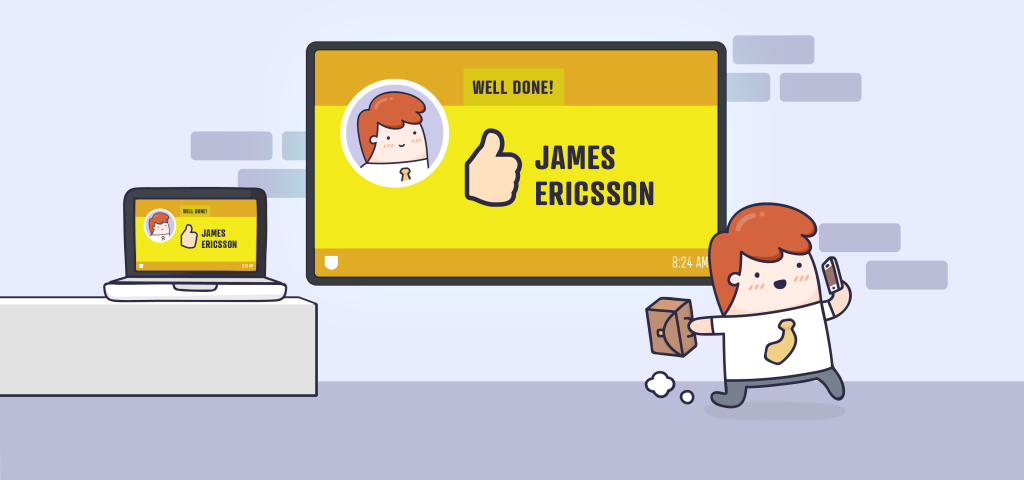How to Strengthen Your Organizational Culture with Internal Communication and Hall’s Cultural Iceberg Model
Estimated reading time: 10 minutes
In the latest installment of our organizational culture blog series, we discussed organizational culture as described by Edward Hall’s Cultural Iceberg Model. In Hall’s Model, he describes organizational culture as an iceberg–Organizational Culture, like an iceberg, has the typical feature of being disproportionate in its visibility. Some aspects of it are easily perceived; some parts are submerged in the values and basic assumptions of the organization. In this follow-up, we’ll be looking at how to strengthen level 1 of your organizational culture with internal communication and the Cultural Iceberg Model.
Table of contents
Some aspects of organizational culture are visible or perceivable for employees and outsiders. These aspects are in level one: the artifacts. These perceivable or perceptible aspects of organizational culture will be different in every organization. However, in every organization, they are the aspects that are formed by people based on what they hear, feel, and see about the organizational culture and its leadership. We already named some of these aspects in our previous blog, but how can you use internal communications about them to strengthen your organizational culture? These are some artifacts of organizational culture:
1. Appearance
Your staff’s appearance can highly influence how employees and outsiders perceive your organizational culture. Do your employees come to work in shorts and t-shirts, or do they wear formal wear? Organizations with a casual dress code are perceived as having a more positive work environment (‘Hey, you can be who you are with us!’).
Rather than worrying about their appearance or being distracted by stiff clothing, employees can focus all their professional energy on their tasks, which may increase productivity. Think about it: when you get home from work (or when you work from home), don’t you switch into something comfier most of the time because it feels better? I’m sure I’m guilty of changing into sweats the minute I get home! Studies even show 61 percent of employees are more productive when the dress code is relaxed.
Communication about this artifact
Although a more relaxed dress code might increase productivity for some organizations, a formal dress code is sometimes still the rule. In, for example, finance or law realms, suit-and-tie are preferred. Client-facing employees are usually part of your brand image. Therefore, it can be helpful to communicate some ground rules about how you want your culture and brand image to be exposed through your employees’ appearance. Set up a page in your SharePoint and connect it to your digital signage screens or your employees’ corporate app, so all employees know where to find this kind of practical information.

2. Language
Language matters for an individual’s perception and interaction with the world. Therefore, the language you use in your organization acts as a moral compass for your employees, affecting how they feel, act, or think in different situations. Your organization’s language shapes its culture, and its culture shapes its people. Language can be used to exclude just as effectively as to include. The way we phrase or frame information and choosing what words, what tone we use becomes crucial to your organizational culture.
For example, expressing what you want to happen instead of what you don’t want to happen can guide employees to show the desired behavior and reflect a positive attitude and a can-do mentality, which will trickle down into your culture. The way you phrase your mission statement and values can significantly impact how employees do their job. The language employees use in their emails to clients can influence how the organizational culture comes across to outsiders.
Communication about this artifact
To make sure you use the same tone of voice, you can form clear guidelines on your organization’s desired language, tone of voice, phrasing, et cetera. Document it on your intranet and share it with all your employees, so they know how to use language in their interaction with clients or colleagues. Communication templates can be a part of these guidelines. At Netpresenter, for example, we have created an internal lexicon so that we all use the same chosen words and use language that we feel fits our organization. This can be useful, especially when discussions arise about the use of certain words.
However, through internal communication, you’re also giving the right example. Repetition is key, so if you want your employees to use certain kinds of words, make sure you use them repeatedly yourself. If you want your employees to live by your carefully stated mission, repeatedly show it through your digital signage on big screens in public spaces. That way, it stays top of mind. Your internal communication is part of your organization’s language and is, therefore, a significant factor in shaping your organizational culture.

3. Technology
The technology you use can give your organization a young and tech-savvy appearance like Netpresenter has, or an old-fashioned, stiff, and even incompetent appearance. Technology that works as it should and fits into the organization’s goals and strategy can reinforce a positive, productive, and winning culture amongst your staff. However, technology that lacks adequate efficacy and is not aligned to your beliefs and values can feel redundant and can turn positivity and productivity into demotivation and frustration.
‘The screensavers enable us to send out alerts whenever there’s a downtime of any of our systems. When we use the screensavers, we’re sure everybody gets the message.’
Communication about this artifact
People will understand technology and systems sometimes need an update, or downtimes can occur. But when nobody has told them their system would be updated, and they come to work just to find out there is downtime in one of their systems again? That will cause frustration and demoralization, which will sooner or later seep through into the organizational culture.
Sky Lakes Medical Center, one of our clients, has a great solution to this problem. Sky Lakes uses corporate screensavers to send out alerts that communicate downtimes of their systems. John Gaede, Director of Information Services at Sky Lakes, explains how this works: ‘Feedback we consistently received around this topic in the past from staff across multiple departments reflected their frustration. They told us: we need you to communicate with us so that we can do our job. The screensavers enable us to send out alerts whenever there’s a downtime of any of our systems. When we use the screensavers, we’re sure everybody gets the message. And then we use the alerts to validate the system is back up when it has been restored.’
Sky Lakes shows they care for their employees and put them first by keeping them informed on everything they need to do their job. This reflects in their culture; it reinforces a strong and productive organizational culture that puts people first and enables them to do their job at their best.
4. Perks and benefits
This is among the first things employees speak of when asked about their organization’s culture: the in-house gym, the free lunches, the Friday afternoon office drinks, the foosball table, or the massage therapist who keeps colleagues’ muscles lose – during working hours! At Netpresenter, we like to play a game of FIFA on our PlayStation during lunch break to blow off some steam in between work. However, perks and benefits are also flexible working hours, paid leave, work from home options, and other efforts to increase employee wellbeing.
Communication about this artifact
Perks and benefits are a sign you care for your employees’ wellbeing. They show you put your people first to make them happy – and happy employees are productive employees. So, make sure you understand what drives your employees to do the best they can and see which perks and benefits can add to that. The best way to do this is to ask them by deploying your internal communication channels such as Microsoft Teams, digital signage screens, or corporate screensavers. Be sure also to use these channels to communicate about any perks and benefits and enable employees to click straight through to essential pages on benefits in your SharePoint environment. This way, employees know what you are doing to make work as pleasant as possible: work hard, play harder!

5. Rewards and recognition
Rewards and recognition have an enormous impact on organizational culture. Workplace recognition motivates staff, provides a sense of accomplishment, makes employees feel pride for their organization, and makes them feel valued for their work. Recognition boosts individual employee engagement, increases loyalty to the organization, increases retention, and boosts productivity. Recognition creates a perception amongst employees about their organization’s values and beliefs and what it stands for. Rewards and recognition emphasize that an employee’s work is valuable and meaningful to their organization.
Besides communicating how valued someone and their work is, recognition provides motivation and sends a message to other employees as to what success looks like. In this way, recognition can be both a tool for individual rewards and employee engagement and an opportunity to fortify the desired organizational culture to other employees.
‘When a team does something noteworthy, I go by, take a picture, and put the news on the screensavers and digital signage. The teams knows everyone on staff will know about their achievement, which makes them feel appreciated.’
Communication about this artifact
Rewarding and recognizing employees can be done privately and publicly, but employees who go above and beyond to do a great job need recognition for their hard work. Highly engaged organizations with strong organizational cultures provide multiple recognition programs via various channels.
For example, peer-to-peer recognition programs enable employees to celebrate their peers: 89 percent of HR professionals reported peer feedback having a very positive or somewhat positive impact on their organization. Peer feedback programs can be enabled by setting up peer-to-peer recognition channels such as a public channel in Microsoft Teams or a channel in your corporate app where employees can give their peers kudos for doing a great job.
Our client Brooklyn Hospital Center deploys their screensavers and digital signage screens to recognize their employees publicly for a job well done. Brooklyn Hospital Center’s Senior Writer & Editor Eric Sommer explains: ‘The TV and PC Screens have had a huge effect on improving employee satisfaction and morale and on building a sense of community. When a team does something noteworthy, the so-called small victories, I go by, take a picture, go back to my office, and put the news and the picture on the screensavers and digital signage. The team knows everyone on staff will know about their achievement, which makes them feel appreciated. It has this immediate ‘Boom, make them feel good’ effect.’
Through public recognition, the Brooklyn Hospital Center makes its employees feel proud to be part of the team. It reinforces a positive culture that employees want to be a part of – a great way to shape a strong and winning recognition program and make employees feel valued.
Did we inspire you to get started on building a winning organizational culture through internal communication? Get in touch with our consultants for a consultation; they would love to help you reinforce your organizational culture! Are you curious about tips on levels 2 and 3 of the Cultural Iceberg? Keep an eye on our blog for the follow-up! Or download the free infographic which explains why organizational culture is important.

